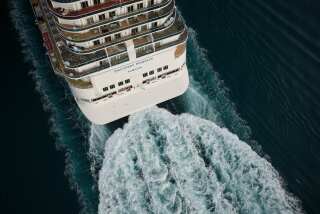Casual Dining Codes Rock the Boat
- Share via
Dining is a major part of cruising for many passengers, even if they don’t want to admit it. In the last year or so, an epicurean revolution is shaking up some cruise traditions.
On large ships it has been customary to assign passengers to a table at a set time each evening, either “early” or “main” seating around 6 p.m., or “late” or “second” seating around 8:30. Each evening’s dress code was printed on the daily program, which requested that passengers wear casual, informal or formal attire that evening. Passengers had the same dinner companions, the same waiter and busboy, the same wine steward and maitre d’ throughout the cruise, and the night before disembarkation they tipped those who had served them.
Then along came some expensive boutique lines, like Seabourn, Silversea and Radisson Seven Seas, that thought their passengers would prefer to arrive at the dining room randomly and sit where and with whom they pleased. Because this clouded the tipping issue, the basic cruise fare was structured to include gratuities, which were then issued equally to all wait staff, eliminating the exchange of money between passenger and servers.
The dining revolution was underway.
Rocking the boat first in the mainstream was Norwegian Cruise Line, which last summer promoted what it called “freestyle cruising” aboard the new Norwegian Sky. Passengers were free to enter any of the ship’s dining rooms at any time during the evening and sit anywhere.
“Resort casual” attire was the only dress code throughout the ship, with one dining room reserved for passengers who wanted to don formal wear on the captain’s welcome-aboard evening. “And if there are some passengers who want to sit at the same table with the same waiters every evening, we can arrange that as well,” says Klaus Lugmaier, hotel manager for the Norwegian Sky.
Gratuities were added to the passenger’s charge account at the end of the cruise. In January, Los Angeles-based Princess Cruises announced “personal choice” cruising, in which passengers, at the time of booking, could specify whether they wanted an assigned dining room, table and seating or preferred restaurant-style open seating.
Contrary to expectations, early in the conversion two-thirds of the passengers requested traditional assigned seating, said Dean Brown, executive vice president of sales, marketing and customer service for Princess. Passengers on this summer’s sailings to Alaska aboard the Sun Princess, Dawn Princess, Sea Princess and Ocean Princess will have their choice of dining plans, Brown said.
In another departure from tradition, Princess is allowing passengers arriving for their cruise to board in time for a leisurely lunch instead of holding them in the terminal until all the cabins are ready, usually around 3 p.m.
Princess is also offering “flight choice,” giving passengers their air/sea flight schedules 60 days ahead of sailing, allowing them time to make changes if they wish.
Carnival Cruise Lines has come up with “total choice dining,” offering four dinner seatings instead of the usual two on all their ships with two dining rooms. Many passengers who prefer the traditional seating say they enjoy cruising because of the people they meet at their assigned dinner table, who often become friends, and their wait staff, who give better service because they know the diner’s individual preferences. Some travel agents worry that service will deteriorate when waiters do not depend on satisfied passengers for tips.
Perhaps the last word comes from cruise ship waiters, who report they like the new system of prepaid gratuities because they won’t get “stiffed” at the end of the cruise by passengers who slip away without leaving a tip.
*
Shirley Slater and Harry Basch travel as guests of the cruise lines. Cruise Views appears the first and third week of every month.
More to Read
Sign up for The Wild
We’ll help you find the best places to hike, bike and run, as well as the perfect silent spots for meditation and yoga.
You may occasionally receive promotional content from the Los Angeles Times.






